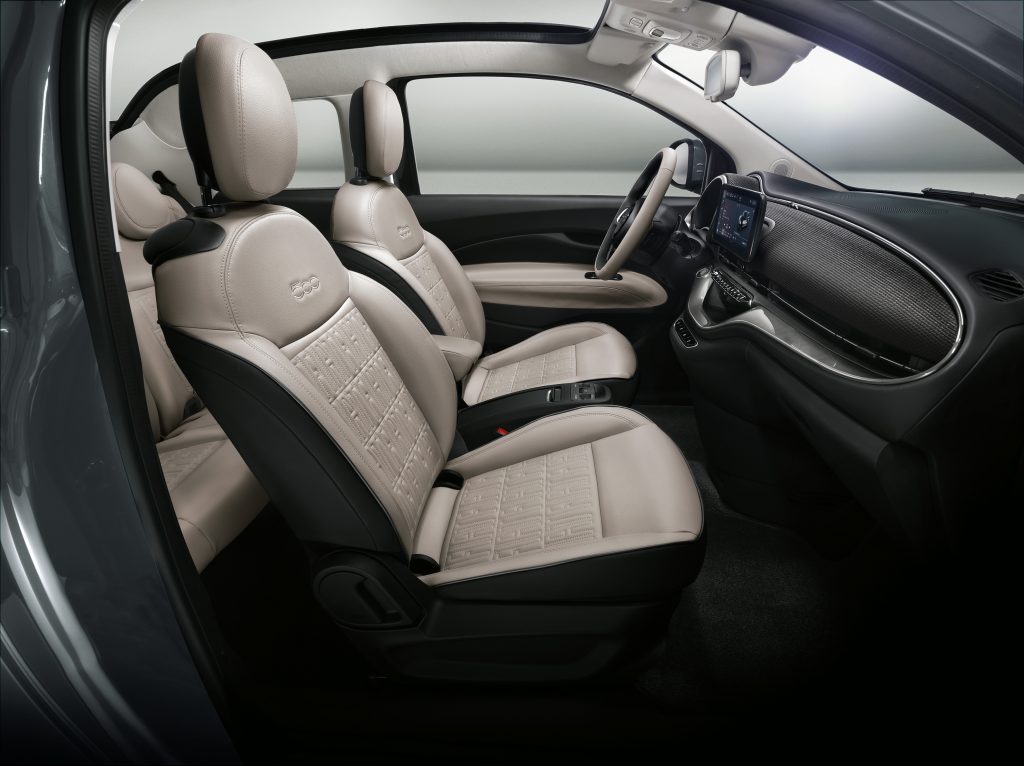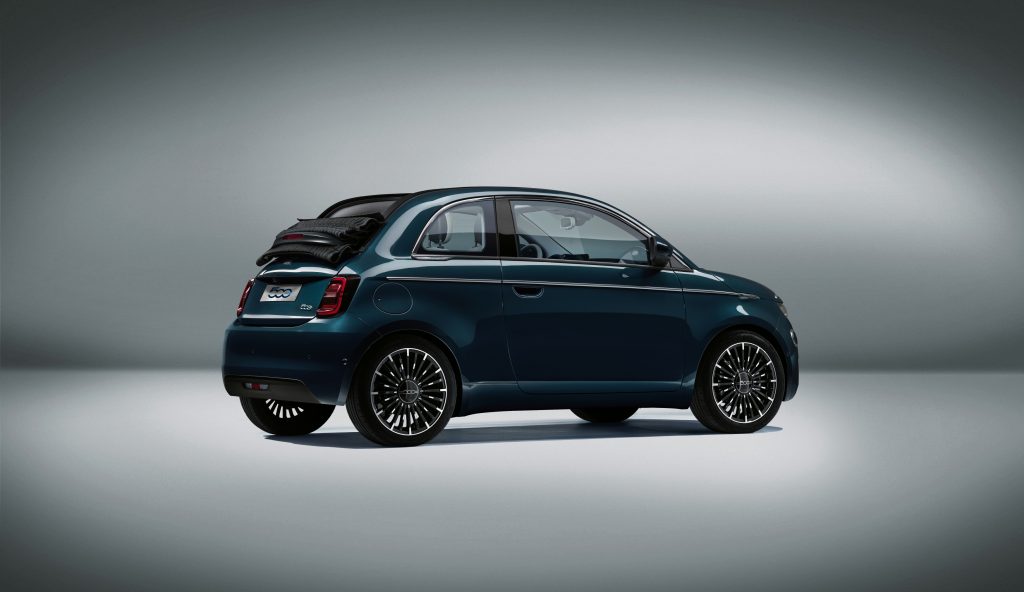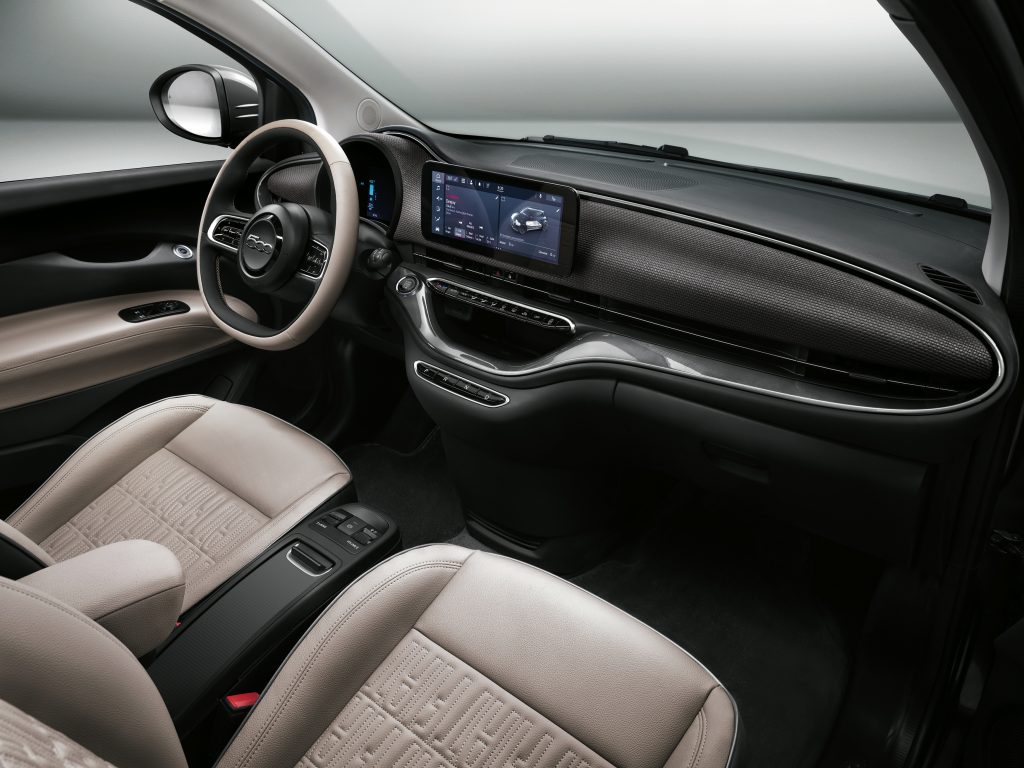THE LITTLE FIAT 500 has entered its third generation but as a fully electric model. More space, more technology and a new style, but still unmistakably a Cinquecento.
The following details have been sourced from an international press release, so it is questionable how much will apply to local 500s when they finally arrive.
The best possible range, charging and driving
When designing the new 500, the engineers started with a blank sheet of paper, so they could work on every aspect with the utmost attention to detail and choose the best solutions.
Range and charging times are two key issues for customers. The lithium-ion batteries with a capacity of 42 kWh give the new 500 a range of up to 320 km in the WLTP cycle.
To optimise charging time, the new 500 is equipped with an 85kW fast charger system to charge the battery very quickly. For example, it takes only five minutes to build up a sufficient energy reserve to travel 50km, more than is needed for average daily use. And the fast charger can also charge the battery to 80 percent in just 35 minutes. The Combo 2 socket located on the rear right side panel of the car powers the fast charger, for both AC and DC charging.
Home charging solutions are also available. The launch edition of the new 500 includes the Easy Wallbox, a home charging system that can be connected to a normal home outlet. ENGIE EPS developed this exclusively for FCA, and it will be marketed by Mopar in Europe to coincide with the launch of the model (plans for Australia, if there are any, have not been released). It is a simple, accessible “plug-and-charge” solution that can be managed easily via Bluetooth, letting you stabilise your energy load by charging your 500 immediately at home with up to 3kW of charging power, with no need for any intervention by skilled personnel. Moreover, the Easy Wallbox is ready for a power upgrade to 7.4 kW, providing a full charge at home in just over six hours. The model also comes with a Mode 3 cable for charging from the public mains.

The new 500 has three driving modes: Normal, Range and Sherpa, which can be selected to match your driving style.
In particular, Sherpa mode optimises the available resources to ensure that you will reach your destination. Sherpa driving mode works on several components to reduce fuel consumption to a minimum, precisely to ensure that you can reach either the destination set on the navigation system or the nearest charging station comfortably. Just like a “Himalayan Sherpa”, who is in charge of the whole expedition and guides it to the destination, this driving mode adjusts various parameters: maximum speed, limited to 80 km/h; accelerator response, in order to reduce energy consumption; and deactivation of the climate control system and heated seats (the driver has the option of activating them at any time).
“Normal” mode is as close as possible to driving a vehicle with a normal combustion engine, while “Range” mode activates the “one-pedal-drive” function. By selecting this driving mode, you can practically drive the new 500 with the accelerator pedal alone. In fact, releasing it causes much greater deceleration than with a normal combustion engine, almost as if you had pushed the brake pedal. In any event, you need to push the brake pedal to bring the car to a complete stop. However, in daily use and with more practice, you can eventually learn to drive it using the accelerator pedal only.
The engine has an output of 87 kW, providing a maximum speed of 150km/h (self-limited) and acceleration from 0-100 km/h in 9.0 seconds and 0-50 km/h in 3.1 seconds.
Level 2 autonomous driving and connectivity
The new 500 is the first car in its segment to offer level 2 autonomous driving, bringing all the associated benefits to urban mobility.
Front-facing camera monitoring technology monitors all areas of the car, both longitudinally and laterally. The intelligent Adaptive Cruise Control (iACC) system brakes or accelerates in response to anything: cars, cyclists, pedestrians. Lane Centering keeps the vehicle in the center of the lane when the markings are correctly identified (always questionable on Australian roads).
Intelligent Speed Assist reads the speed limits and recommends applying them, while Urban Blind Spot uses ultrasonic sensors to monitor the blind spots and warn of any obstacles with a triangular warning light on the wing mirror. Then there is Attention Assist, which provides warnings on the display, recommending that you stop and take a break when you are tired. Finally, the 360-degree sensors provide a drone view to avoid any obstacles when parking or performing complex manoeuvres.
The third-generation 500 is the first FCA car equipped with the new UConnect 5 infotainment system, the connected platform designed for the future. Developed with the idea of providing customers with a completely new user experience in mind, FCA uses the easy, intuitive and incredibly customisable Android Auto operating system. For example, you can use widgets to configure how functions and apps are displayed. Apple CarPlay is already available wirelessly. The system is also ready to offer the same functionality for Android Auto.
In short, the new 500 offers seamless integration with your smartphone, offering a 10.25-inch high-definition touchscreen, with a horizontal form factor that fits perfectly into the car dashboard, following its lines.
The launch version also boasts the Natural Language interface system, with advanced voice recognition, so you can talk to the car to control parameters, set the climate control and choose your favourite music.

Style and design
The new 500 has all the elements of style, just quieter, cleaner and crisper. The front is vertical as in the 1957 version. The dividing line of the first generation separated the bonnet from the circular headlights, while today that separation has been redesigned, dividing the modular elliptical headlight with an eyelash on the bonnet. The slightly more elliptical, still-iconic headlights are technological and modern, resulting in a more appealing look, while the door handles are completely flush, with a compartment for the electric unlocking.
The 500 is six cm wider and six cm longer, the wheelbase has been extended by two cm, and the wheels are larger and further apart, giving it a stronger personality and greater comfort despite its length remaining under four meters.
Inside, the electric 500 is completely new and elegant, with clear references to elements of the first generation. The dashboard is wide and slender and modular storage solutions between the two front seats where the gear shift console was originally located, significantly improve comfort and practicality. There is more space behind the shoulders and for the legs, while the flat bottom can house the lithium batteries without compromising the luggage compartment capacity, which remains unchanged. The result is a well-thought-out and cleaner environment, with fewer buttons and crisp, harmonious lines that are all about sustainability. As for the Hybrid Fiat 500, including the electric version, some trim levels also have seats made using “Seaqual” yarn, derived from plastic recovered from the sea, while others make considerable use of eco-leather rather than real leather.
The “La Prima” launch edition is available for pre-booking
A dream is coming true: the “La Prima” launch edition, a limited edition designed for the launch of the New 500, with its own distinct style, exclusivity, technology and connectivity (once again, seniordriveraus is unsure whether any or all of these variants will reach Australian showrooms, but your Fiat dealer will be happy to advise).
La Prima is available in three colours: Mineral Grey (metallic), Ocean Green (pearlescent), Celestial Blue (three-layer).
The launch version also features full LED headlights, eco-leather upholstery, 17-inch diamond-cut wheels and chrome-plated inserts on the windows and side panels.
Those who desire the new 500 “La Prima” require all its details to be exclusive: the Monogram Soft Top, and the “1 of 500” numbered badge alongside the name of the country in which the car was purchased on the first 500 units sold in the main countries.
The “La Prima” full-option convertible is the only electric four-seater convertible. It comes complete with new content as standard, such as the 85kW fast charger and an interior with eco-leather dashboard and seats.

The One-offs
(from here on, we decided to leave Fiat’s language exactly as presented – those of a sensitive disposition may wish to skip to the next seniordriveraus story)
Three One-offs will be presented in Milan. Companies such as Giorgio Armani, Bvlgari and Kartell, symbols of Italian excellence around the world, have shared in the new 500 project by creating three unique models to celebrate the arrival of the first the project of new 500.
500 Giorgio Armani
Only Giorgio Armani, the undisputed king of the world of Italian elegance, could be the one to interpret the style. His haute couture house interpreted their version of the electric 500, the 500 Armani, in the name of timeless tailoring and sustainability. Using laser technology, Armani wished to shape the metal covering of the car’s bodywork (and eventually etching it) with exclusive microchevron engraving, bringing it as close as possible to the three dimensions of a fabric. The result is further enhanced by an Armani grey-green “silk effect” colour. What’s more, the opaque paint used for the exterior is an innovative product. While the “GA” logo is a strong feature of the wheel design and customises the fabric of the soft top, while the amber-colored windows raise the car’s level of harmony and sophistication.
The neutral and elegant nuances continue in the interior: the seats are upholstered in certified full-grain natural leather, sourced from Poltrona Frau, in a “greyge” colour with microchevron wool bands, embellished with details taken from the craftsmanship of the best leather goods.
The naturalness and authenticity of the materials is also emphasised by the sinuous and sculptural dashboard insert, covered with reconstituted open-pore wood embellished with thin layers of aluminium inlay, inspired by the elegance and contemporaneity of the Armani/Casa line.
B.500 “MAI TROPPO”
Bvlgari’s One-off B.500 “MAI TROPPO” is a homage to craftsmanship and beauty. 500 has always played a role in La Dolce Vita, an Italian icon born of the love for beauty and art. The new interpreter of these values is Bvlgari, an emblem of Italian excellence, a brand that has innovated over the years by rewriting the rules of world jewellery and launching new trends that have become icons of contemporary design. The new 500 is a true gem in its own right, with its interiors in the finest materials, embellished by the greatest attention to the details and unique finishes that recall the vivid, unmistakable combinations of colours and motifs and exalt Bulgari’s Roman origins.
It could therefore take no other name than “MAI TROPPO” (“never too much” – how ironic is that!)
The One-off features a saffron-coloured pearlescent paint, an iconic shade at Bvlgari inspired by the chromatic variegation of Roman sunsets. This effect is enhanced by a nuance in the paint produced by expert manual technique. The “saffron” paint emphasises the character of the car as a “jewel”, based on the inclusion of gold powder, recovered from the scraps of jewellery production. The end result: an environmentally friendly car, resplendent in its own light. In addition to the gold paint, the B.500 has side sills and front mouldings processed using the glazing technique; specifically designed wheels in the form of a star, the historical symbol of Bvlgari, along with black lacquer with gold trim and a side “jewel” badge in polished gold, with a diamond-paved B.500 logo. The philosophy of re-use continues in the interiors, with a dashboard fascia made even more elegant by its upholstery with heritage Bvlgari silk scarves from the collections of the past. The seats are in teal leather with “Diva” pattern embroidery, gold details and scarf inserts. The true jewel of the interiors are three semi-precious stones, amethyst, topaz and citrine, set in a removable brooch, made by the master goldsmiths at Bvlgari and placed in the centre of the steering wheel.
500 Kartell
Creativity and innovation are the elements of inspiration for the 500 Kartell One-off, from the iconic brand of Italian industrial design, which constantly experiments and researches new aesthetic and functions vernaculars for plastics. In recent years, Kartell has also been involved in developing increasingly sustainable plastics.
The new 500 Kartell is an ideal mixture of materials that come together to breathe life into a true object of contemporary design.
The exterior features a “monoblock colour” concept where the different types of materials – metal, glass, rubber, plastic and fabric – are interpreted in the same colour: Kartell blue, derived from Yves Klein blue, a universally recognised colour iconic of the brand. The surfaces of the bodywork are mirror-effect Kartell blue, obtained using a blue Kartell mirror effect obtained with an environmentally friendly chrome paint. The two brands’ logos stand out from the bodywork thanks to treatment with a sandblasted polycarbonate, to convey a sense of material and depth.
The most symbolic elements of the exterior, in addition to the colour effect, are the components made of polycarbonate recycled from end-of-life parabolic projectors, used in the front grille, wheels and mirror caps. These objects feature a unique design inspired by the pattern of Kartell’s Kabuki lamp, created and developed by the designer Ferruccio Laviani as a motif to lead the new car’s identity, with unique details that recall the texture of the lamp and become special elements of the car. The Kabuki pattern remains the protagonist in the interiors, with a polycarbonate cover on the dashboard insert and transparently applied to the seats.
The contrast between the Kartell blue of the exterior and the brightness of the interior is striking, providing a clear and light environment, combining warm and cool hues. The tactile textile plastics used in the interior are 100% recycled polypropylene, just like the chairs from the latest Kartell collection. The fabrics take on a natural, cosy look, in fully recycled polyester.
